Weekly review: 7th – 13th March 2012
A sizeable blocking high pressure system anchored itself over the country for much of the week, forcing some meaty-looking Atlantic systems well to the north of us whilst allowing a day or two of super early spring sunshine to nudge the temperatures in to the high teens once again.
However, as the round-up period drew to close many places were, although dry and mild, shrouded by cloud of varying tones of grey and white….
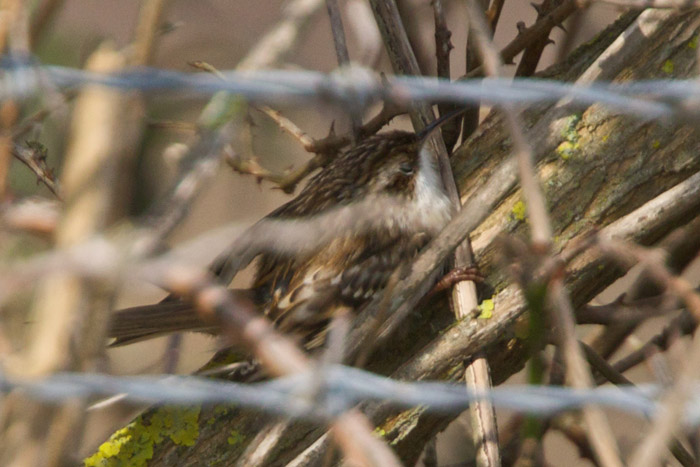
As was touched upon at the end of the previous round-up, the migrant corridor was indeed opened a little wider this week, thanks to some decent conditions to the south of us. The first Wheatears and Swallows arrived, along with several Ospreys and Garganeys. Also, as predicted, the agreeable weather ensured that the first major spring overshoot of 2012 made landfall over the weekend…
The Short-toed Treecreeper found at Samphire Hoe CP in Kent, during the early afternoon of 10th, became the earliest spring arrival for this notoriously tricky to catch up with species, beating the previous record date (set by last year’s well-watched bird at Landguard Point) by a fortnight.
Kent’s dominance with regard to the number of records of this single species is almost unparalleled compared with any other major British rarity. This week’s bird, once accepted, will become the 21st record for the county, with just five others accepted away from Kent (excluding the in-circulation Landguard bird mentioned above). Essex and Dorset share two records a piece (one of the Dorset birds, a wintering individual on Portland in 1970-’71 was initially rejected but did eventually make it on to the list) while East Yorkshire’s lone record, at Hornsea Mere in late October 1970, remains the only bird noted away from the south coast.
During the period from 2000 - 2010, four Short-toed Treecreepers were found in Kent ~ before that eight were seen in the 1990’s, three in the 1980’s, four in the 1970’s (including two together at Dungeness from 7th-10th October 1978). “Dunge” has now hosted a remarkable (though perhaps unsurprising) 13 Short-toed Treecreepers and it was there that Britain’s first-ever Short-toed Treecreeper was found ~ trapped at dusk in a mist-net at by the late Bob Scott at the end of September 1969. More on Bob in a wee while….
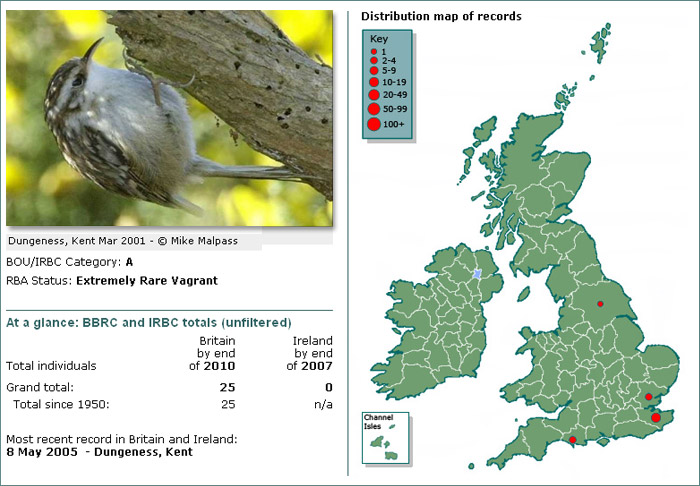
Rest of Britain 20 - 5 (Data from our Previous Records database)
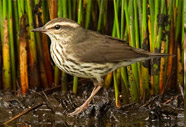
BOU/IRBC Status: A
RBA status: Extremely rare
Accepted British records: 6
Accepted Irish records: 1
Most recent accepted record:
14 - 17 Oct 1996 - Portland, Dorset
Prime month(s) to occur:
September - October
On the Isles of Scilly, on St. Mary’s, the first-ever wintering Northern Waterthrush was seen again near the tin hut on Lower Moors on 7th. At some point soon, its migratory instincts are going to kick in and it’ll be on its way ~ and when it does it will end a record-breaking stay that started on 16th September last year.
Prior to this, the most recent Northern Waterthrush to offer itself up was the bird that shared Cape Clear’s central bog with a Solitary Sandpiper in August 2008 (with, of course, a luminous Yellow Warbler nearby too…) while Britain’s most recent bird before the current Scilly individual was the much-twitched bird at Portland Bill in mid-October 1996.
The Dorset bird was only the second mainland record of this secretive mega ~ the other was a trapped (and suppressed) bird at Gibraltar Point on 22nd-23rd October 1988. Famously, both Cliff Swallow and Indigo Bunting also made landfall on the English east coast around the same time, the former on 23rd in Cleveland, the latter on 21st in Norfolk ~ although, equally famously (!), only the Swallow and Waterthrush were given the official thumbs up…..circumstantial evidence of no use then m’lud???
So, Scilly is to Waterthrushes what Dungeness is to Short-toed Treecreepers ~ the current bird is the fifth to be found on the islands (in a total of eight for Britain and Ireland combined) and Britain’s first-ever Waterthrush shares a neat connection with Britain’s first-ever Short-toed Treecreeper……
….and that connection is…Bob Scott. The Waterthrush found at Covean, St. Agnes on the morning of 30th September 1958, was found and identified by Bob and G. J. Harris. Then, almost to the very day, 11 years later, Bob was on hand to add Britain’s first Short-toed Treecreeper to the British list.
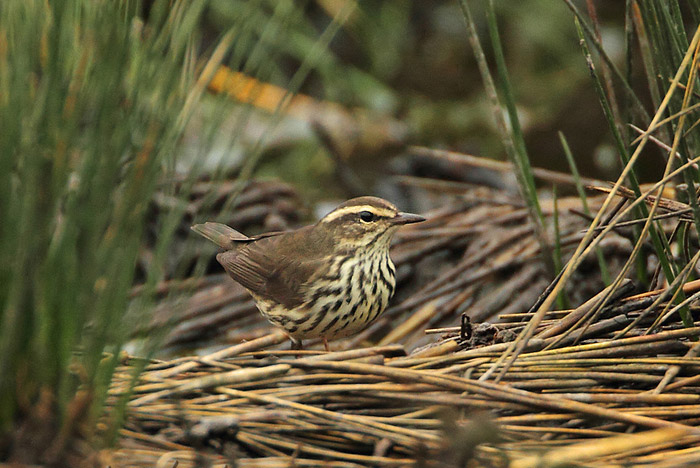
Another wintering American wood-warbler, the first-winter male Common Yellowthroat at Rhiwderin, near Newport remained over another weekend and on to 13th (after a spell of not being reported for four days), while the third member of the crack team of American wintering passerines, the lovely male Slate-coloured Junco (Dark-eyed Junco ~ yuk!) was still in the clearfell area near the car park at Hawkhill Inclosure, in the New Forest, until 11th at least.
Another very popular North American wintering visitor this year has been the Greater Yellowlegs that spent a decent amount of time in the Highlands (after its quirky hop from the north-east) before popping up over the visitor centre at Loch of Strathbeg last week. This week it reappeared at Strathbeg and showed every day from 9th-13th. Its the second record for the county, the other was on the Ythan Estuary for a day in late October 1957.
Back down to the south coast and in Hampshire, the male Spanish Sparrow geared up for spring in the gardens at Calshott, present throughout the week and he is likely to be present for some time to come too…..Will any of the local females fall for his Mediterranean charms? It will become clear, soon enough.
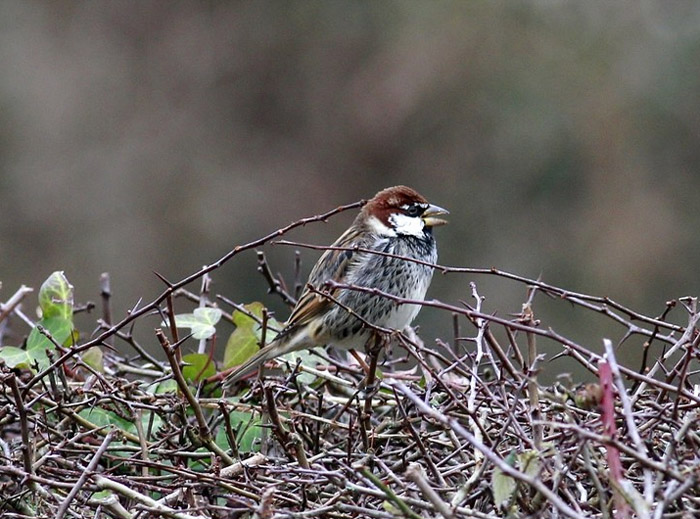
A little further to the east, along the south coast in West Sussex, along the North Wall at Pagham Harbour, the wintering, now singing Paddyfield Warbler was seen throughout the week, to the end of the round-up period.
Some interesting negative news to end this section with ~ as was touched upon last week, the female Bufflehead in west Cornwall appeared to be on the move and she’s not been seen all week. Interestingly, and one that will please those who made a trip to Whetsted, the female Hooded Merganser also appears to have read the rule book and done a bunk….
Once again, there’s no real surprise that there wasn’t much in the way of action out to sea this week. A White-billed Diver was reported from Ardvane, on Islay, on 12th and another was seen at sea off the Moray coast, north of Buckie (with 100 Great Northern Divers) on 13th. Two Little Auks were seen off South Ronaldsay (Orkney) on 9th and further singles was reported off the Norfolk coast, at Cley, on 7th and Titchwell on 12th. Three single Pomarine Skuas were logged, one each for West Sussex, Essex and Suffolk.
New this week, and a typical early spring overshoot, were the Night Herons that appeared in the southwest of England from 12th. Leading the way, a flock of four that made landfall at Woolacombe on the north Devon coast, with another in the Cornish valleys, at Kendijack. The Cornish bird spent some time around the pools and stream at the seaward end of this pretty valley and all five were present the following day. Then came news of a sixth bird in this mini-invasion ~ another for north Devon, seen at Halsinger Down during the evening of 13th. Time will tell if these are the vanguard of a significant influx. If they are, could numbers exceed those of the totals of March 1990, when at least 15 arrived in the far southwest (along with a peppering of early Hoopoes and Woodchat Shrikes). A “possible” Night Heron was also reported from Tralee, in County Kerry, on 12th.
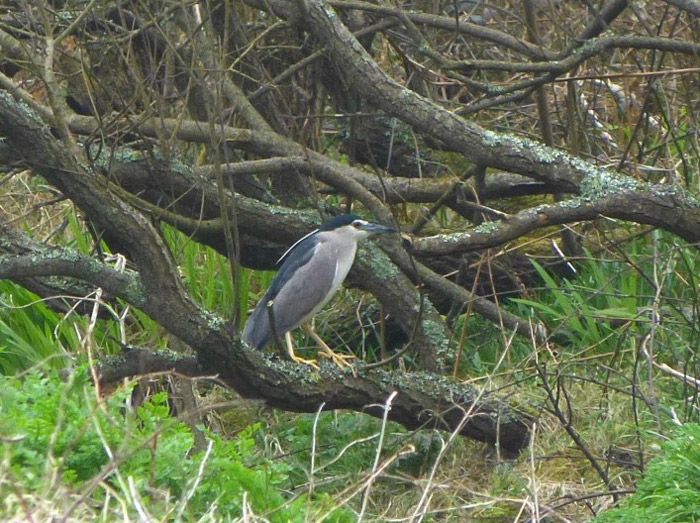
There was still plenty of action for those who have a penchant for Glossy Ibis ~ Norfolk and Pembrokeshire both hosting groups of four (the Norfolk birds still ranging widely throughout the week across sites in the east of the county, the Pembroke birds seen in flight near Haverfordwest on 9th). It seems likely that those four were new, the trio at Marloes Mere seem to be a tight-knit threesome and were present to 11th at least.
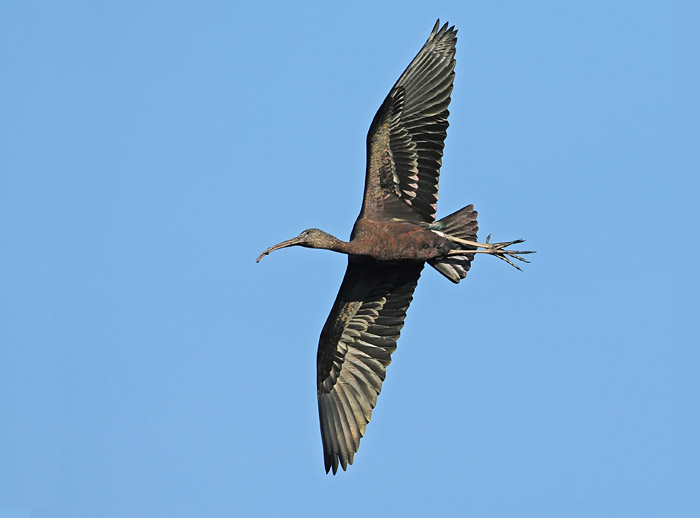
In Lincolnshire, another flock of three was seen heading south along the coast on 9th, heading out over the Wash at Gibraltar Point just before noon. However, the following morning, they were back at their original starting point at Saltfleet.
Two new birds appeared on the Nene Washes in Cambridgeshire on 12th, and other double acts were still in Dorset and Kent, while singles were reported from Lancashire, Cleveland, Suffolk and Essex,. The latter bird was one of the most interesting of all ~ ringed in Coto Donana on 7th May 2007, it had spent three weeks at Borth, Ceredigion in February this year before relocating to Heybridge Basin ~ a cross-country, ESE movement of some 230 miles.

Essex was also host to one of the week’s two Cattle Egrets ~ seen at Frinton-on-Sea on 7th ~ with the other spending a few days in Dorset, at Kingston Maurward. Around 16 Great White Egrets were recorded during the last seven days, including three at Meare Heath (Somerset) on 10th and two together on the Isle of Sheppey on 11th (four birds were in Kent this week). It was otherwise much as last week for the other birds, including two in Wales (singles in Powys and Carmarthenshire) and another in Ireland (in Wexford).
At least 15 Spoonbills were still to be seen in Poole Harbour on 9th and there were two at Lodmoor on 9th-12th ~ these were the only multiple sightings reported this week. On the Nene Washes, nine Common Cranes were at Eldernell on 11th and two were at Worth Marsh (Kent) from 9th-13th. One remained at Nosterfield Quarry in North Yorkshire to 7th and several were distributed around the Norfolk Broads.

Last week, we brought news of a Ross’s Goose in Northumberland, hanging out with Iceland-bound Pink-footed Geese. This week, a Ross’s Goose was again in the same county, with the same carrier species, this time at Budle Bay on 11th.
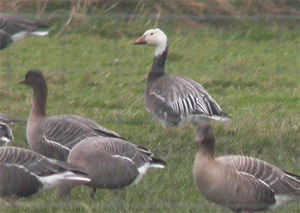
It is quite possible that this may be the second (or third) of Norfolk’s wintering birds heading north, rather than being last week’s bird reappearing. Numbers of Pinks in Norfolk are, as expected, dropping like a stone, so it is no surprise to see another of these distinctive cute little geese being tracked on its springtime migration flight.
The flock of 30 or more Snow Geese were at Dungeness on 7th, with perhaps six of those accounting for the group that flew east past Seaford (East Sussex) on 12th. Single birds whose provenance may be a little more agreeable were seen at Douglas Water (Clyde) from 7th-13th, at Lower Lough Macnean in Fermanagh on 7th and Lessonhall in Cumbria on 12th (the former white, the latter two blue).
There were still up to four different Red-breasted Geese on offer this week ~ a first-winter was keeping the Dark-bellied Brents company in the Suffolk creeks to 9th and another first-winter was still in coastal fields, with Barnacle Geese, in Dumfries & Galloway to 13th. The Suffolk bird may feasible have been the bird that then pitched up at Old Hall Marshes RSPB reserve in Essex on 11th-13th. Rounding everything up for these beautiful Brantas was the bird in Hampshire, still around the Needs Ore area to 13th.
A Black Brant was again at Penhill Marsh (Devon) from 8th-11th (one was last seen there on 17th February) with others noted on the Isle of Wight, West Sussex and Lincolnshire, with two more in Ireland, in Dingle harbour (Co. Kerry) and Bannow Bay (Co. Wexford), while up to the northwest, in Sligo, three Richardson’s Canada Geese remained at Ballintemple until 12th at least and the Todd’s Canada Goose was still at Ardowen, in Mayo, on 13th.
A new drake Blue-winged Teal was a nice find at Pat Reddan’s Lake, in County Tipperary on 12th ~ it’s actually the third time since 2008 that there’s been a drake at this site (April 2008 and April 2009). Could it be the same ageing bird?
“New” drake Green-winged Teals were discovered at Drayton Bassett Pits (Staffordshire) on 7th and Dorman’s Pool (Cleveland) from 8th and made this week’s tally up to seven ~ the others noted in Hampshire (possibly two there), Essex, Forth, Angus and Wexford.
It was, pretty much, as-you-were with American Wigeons ~ all last week’s drakes became this week’s drakes ~ still to be seen on the Exe Estuary, Anglers Country Park in west Yorkshire, Marlingford in Norfolk, Kirk Loch in Dumfries & Galloway and the Bay of Suckquoy on mainland Orkney.
A drake American Wigeon at Rahasane Turlough (Co. Galway) may have been the same bird seen there in late January (confusingly, a hybrid drake American Wigeon X Eurasian Wigeon was then reported there last month).
The female Lesser Scaup was at Slimbridge WWT all week and the drake in Glamorgan, at Cosmeston Lake was still welcoming all and sundry to 10th at least. Another drake was seen this week, at Chew Valley Lake, on 11th-13th.
A female Ring-necked Duck was seen on Loch Fada on Benbecula on 7th while males totaled six ~ two each still for Cornwall and Ayrshire, while Ireland laid claim to drakes on Dunfanaghy New Lake (Co. Donegal) on 10th and Cuskinny Marsh (Co. Cork) on 11th. In Buckinghamshire, a female or immature Ferruginous Duck spent two days at Linford NR on 11th-12th.

No change for Surf Scoters this week ~ two drakes remained off Llanddulas (Conwy), with single drakes still to be seen in Cornwall, Cork and Fife. The female Surfie was still doing her own thing off the Gwynedd coast to 12th.
In Galway, the young Pallid Harrier was at Lough Corrib all week. Many of the winter’s Rough-legged Buzzards were remaining faithful to their wintering spots, 16 or 17 birds reported this week, though there was definitely some movement in favourable passage conditions. Two birds were at Gedling, in Nottinghamshire, on 11th and one was seen heading over the Spurn peninsula on 7th. Elsewhere, three singles were in Norfolk and other notable lone birds remained on Shetland and, in Northern Ireland, in counties Down and Tyrone.
The first-winter Lesser Yellowlegs remained at Kingsmill Lake in southeast Cornwall to 13th and the wintering Pectoral Sandpiper at Dundonald Camp (Ayrshire) was seen throughout the week. Just one Spotted Sandpiper made it to the new round-up, the adult at Chew Valley Lake present throughout the week.
Wexford’s two Long-billed Dowitchers remained at The Cull to 12th while last week’s (half-cocked) theory of the Kidwelly bird transferring to Bannow Bay seems to have been deemed null and void by virtue of the Welsh bird being seen again on 10th and 13th. Perhaps it commutes across the Irish Sea?!? In Scotland, a Long-billed Dowitcher was again at Wigtown harbour on 7th ~ it was last seen here in January (and has been seen, sporadically, since last autumn).
Three adult Bonaparte’s Gulls saw the discovery of a new bird on the Outer Hebrides, at Stornaway on 10th (the second reported on Lewis this year). The other two were, like many species featured this week, remnants from previous weeks ~ at Ballygalley in Antrim until 9th and Cardiff Bay until 12th.
The week’s most significant gatherings of Iceland Gulls included 34 on Whalsay (Shetland) on 8th, 12 in Dingle harbour on 9th when 41 were counted around Lerwick (presumably some repetition with Whalsay birds?), 13 at Nimmo’s Pier, Galway, 13 at Fanad Head in Donegal and 14 at Corbally Road Reservoir, all on 10th, 20 at Killybegs on 11th (with the Lerwick total now topping 50) and 16 were at Marwiock (Orkney) on 12th. All these counts were beaten by the huge haul of 91 birds in Stornoway harbour on 9th.
Several Kumlien’s Gulls spread themselves far and wide this week (from Kent to Shetland) and the only multiples were seen on Shetland (three there on 10th) and Killybegs (five counted on 11th).
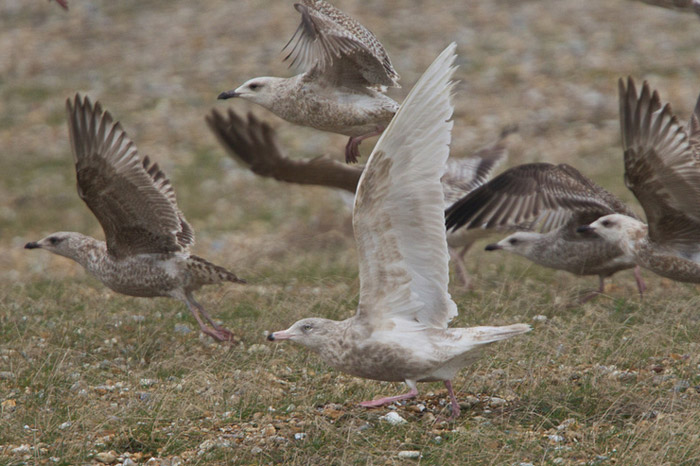
Countless single Glaucous Gulls were rattled up this week, with seven at Marwick and six at Heddle (both on Orkney) on 11th and seven on The Mullet on 13th the largest single gatherings.
A baker’s dozen Ring-billed Gulls lingered in Ireland, with three birds together (two adults and a first-winter) at Blennerville in County Kerry, leading the way on 12th. Cork scored five, with singles in Down, Derry, Galway, Wicklow and Clare. On the opposite side of the Irish Sea, four of the six birds seen were previous weeks’ hangovers with new second-winters on the Teifi Estuary in Ceredigion on 9th – 12th and at Lochgilphead in Argyll on 13th.
Early in the evening of 13th came an unconfirmed report of a female Rock Thrush at Trewellard. Apparently seen in flight three times during the afternoon, there’ll be many people hoping that something comes of the news ~ its been nearly eight years since the last accepted Rock Thrush record, a one day male alongside the River Erme in Devon (on May 26th 2004). That was the only record of the species for the whole of the decade, prior to that its another eight year gap to the next accepted bird, on Scilly in September 1996.
The Black-bellied Dipper that reappeared at Shipley, in west Yorkshire, last week was still in place, off and on, until 12th. Three flocks of Waxwings were noted this week ~ 25 each in Norwich and Sheffield, with 20 in Edinburgh.
In Dorset, the Richard’s Pipit was again at Wyke Regis (Dorset) on 11th and 13th, while next door, in Hampshire, the male Rose-coloured Starling remained at Hordle all week, with birds at Holyhead and Muirhead (on Anglesey and in Ayrshire) also remained for much of the week. The female Siberian Stonechat on the South Slob in Wexford continued to be a popular target for Irish birders this week, showing daily to 12th at least.
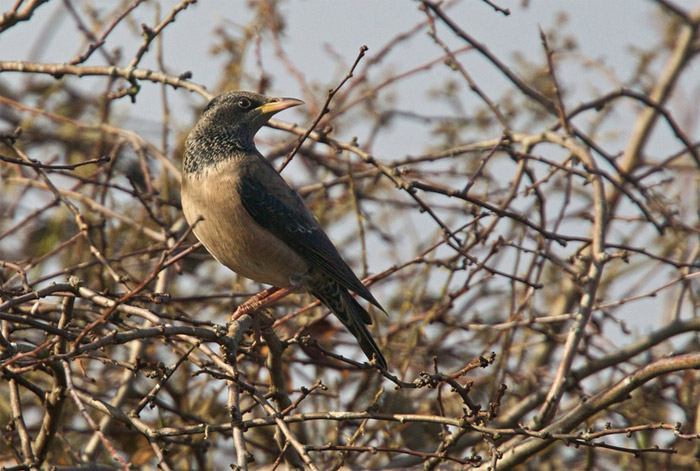
After a gap of over three weeks, the Hume’s Yellow-browed Warbler was reported to be back at Wyke Regis on 11th, while five Yellow-browed Warblers were noted, including a new bird, well inland, at Warndon (Worcestershire) from 10th (others remained in Cornwall, Devon, Somerset and West Sussex).
The Great Grey Shrike tally this week was much as it was last week, although several birds were seen at new sites. Two birds on Thursley Common (Surrey) on 7th-8th and two lingered in the New Forest. New passage birds included singles in Shropshire, Northamptonshire and Northumberland.
In Norfolk, the first-winter Coues’ Arctic Redpoll remained at Titchwell RSPB to 13th while in the out-of-bounds Brecklands bordering Suffolk, a new Coues’ Arctic Redpoll was trapped on 4th (news only emerging on 8th).
Mark Golley
14th March 2012




